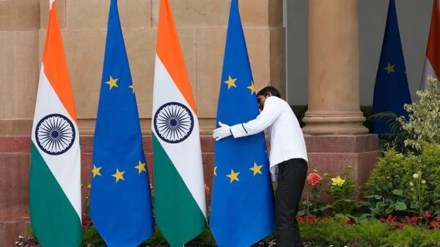India and the European Union (EU) will now remain continuously engaged at the chief negotiators’ level as the deadline for a free trade agreement approaches, and a real breakthrough remains elusive. However, there will be no more formal rounds of negotiations, after the 14th concluded in Brussels recently.
Apart from the “continuous intensive” engagement, negotiations at the political level will continue, a statement by the European Commission said.
Commerce and Industry Minister Piyush Goyal will be in Brussels this month-end for giving a push to the negotiations.
In the 14th round of negotiations that were held between October 6 to October 10 discussions on trade in goods allowed for a constructive exchange covering the text of the Trade in Goods chapter and the market access offers but did not yield any significant breakthrough.
On market access in goods, both sides made their expectations known for tariff liberalisation, red lines and flexibilities, both on the levels of liberalisation and on the staging of tariff dismantling.
Besides demanding significant duty cuts in automobiles and medical devices, the EU wants tax reduction in other products like wine, spirits, meat, poultry, and a strong intellectual property regime.
India’s demands in the negotiations is duty free access to its labor intensive imports and emerging sectors like auto, electronics. Another concern for India in the negotiations is the imposition of carbon tax by the EU on imports of steel, aluminium, cement and fertilizers from January 2026. The tax imposed under the Carbon Border Adjustment Mechanism (CBAM) could put another barrier to India’s exports while tariff barriers are brought down further.
In services trade very few areas of divergence remain and texts of the agreement very close to completion, the EC said.
During the round the chapter on sanitary and phytosanitary measures (SPS) measures was concluded in principle while progress was made on the chapter on Technical Barriers on Trade. SPS sets standards for food safety, plant and animal health. In a trade pact parties agree to common standards on safety for products traded.
TBT deals with standards for products that are allowed into a country. In a trade agreement the standards for each partner are laid down explicitly.
The area where substantial differences remain is Trade and Sustainable Development. Even in the chapter on investment substantial differences remain. Under sustainability India’s concerns on carbon tax being brought in through Carbon Border Adjustment Mechanism (CBAM) and other related regulations related to the environment remain.
For closing the gap in positions on the Rules of Origin chapter the Indian team of officials stayed in back Brussels for talks. Rules of Origin agreement specifies the quantum domestic value addition a product must have to qualify for concessional tariffs under an FTA.
The negotiations on the India-EU FTA began in June 2022. The FTA covers 23 policy areas or chapters, including Trade in Goods, Trade in Services, Investment, Sanitary and Phytosanitary Measures, Technical Barriers to Trade, Trade Remedies, Rules of Origin, Customs and Trade Facilitation, Competition, Trade Defence, Government Procurement, Dispute Settlement, Intellectual Property Rights, Geographical Indications, and Sustainable Development. Agreement on six of these chapters have already been achieved.
